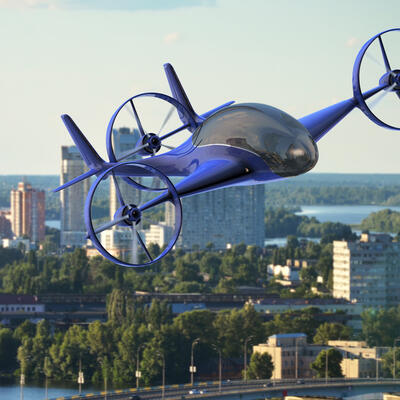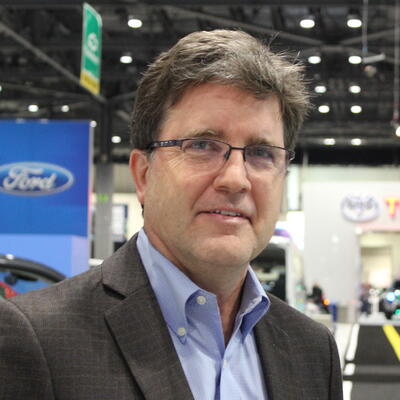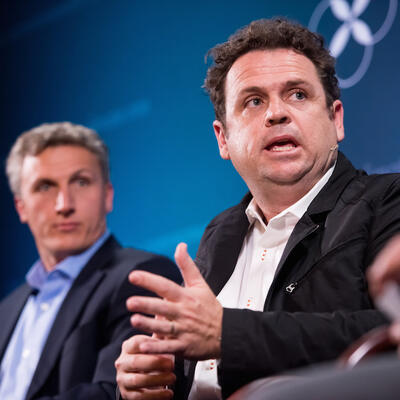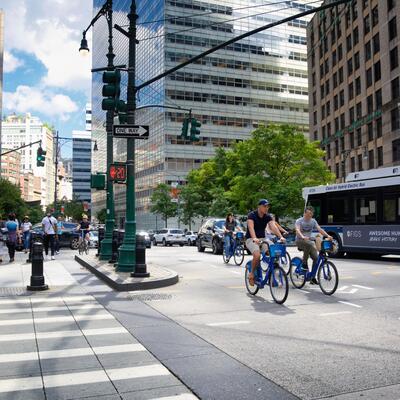
From Wheels to Wings: Our Flying Car Future
Guests

JoeBen Bevirt

Uma Subramanian

Jennifer Richter

Charlie Vogelheim
Summary
Can we beat the traffic by taking to the skies?
For more than a century, the automobile has ruled our city streets, chaining us to grid-shaped streets choked with lines of traffic. And for many of us, seemingly endless hours of daily commuting.
“But what if we can remove those chains?” asks JoeBen Bevirt of Joby Aviation. “What do our lives, what do our cities, how does the world look 20 years from now or 50 years from now? That's what gets me up everyday. So my mission is to save a billion people an hour a day in their daily commutes.”
The ability to sail above the freeways in a flying car, getting to work in minutes instead of hours, has long been the stuff of science fiction. But JoeBen Bevirt is already on his way towards making it a reality. He’s raised more than $100 million to develop a five-seater that he claims will be faster, cheaper and quieter than helicopters. And not just as a plaything for the rich, Bevirt promises.
“We really want to be able to launch this at an affordable price point that’s accessible to everyone,” he says. “That is similar cost to taking a taxi on a cost per passenger mile. And then our ambition is to get it to the cost of personal car.”
Other startups around the world are also developing drones or flying cars. Urban air mobility – or UAM -- is coming.
For now, there are still many challenges to getting those flying cars off the ground, from infrastructure to regulatory issues, from air traffic to zoning. Not to mention mechanics and design – what will the flying car of the future look like? Auto industry consultant Charlie Vogelheim says what comes to mind for most consumers is a cross between the Jetson’s family-sized space capsule and Chitty Chitty Bang Bang.
“The thing that people keep thinking about when they think about flying cars is, ‘where is that car that I can drive and then the wings come out?’”
This program was recorded in front of a live audience at The Commonwealth Club of California in San Francisco on August 20th, 2019, and was made possible by the ClimateWorks Foundation.
Resources From This Episode (3)
Full Transcript
Greg Dalton:This is Climate One, changing the conversation about energy, the economy, and the environment.
On today’s program – taking off on the commute of the future.
Uma Subramanian: The next decade is forecast to be the greatest period of urban migration in human history. Ground infrastructure as currently configured can’t keep up. And so you’ve got two choices. You can take the sort of boring company approach and dig which is very expensive on a per mile basis. Or you can take to the sky.
Greg Dalton:If you’ve ever imagined ditching your car and flying over city rooftops, that day may not be far off. Some innovators are determined to make the flying car a reality. And not just for the wealthy.
JoeBen Bevirt: We really want to be able to launch this at an affordable price point that’s accessible to everyone. That is similar cost to taking a taxi on a cost per passenger mile. And then our ambition is to get it to the cost of personal car.
Greg Dalton: From wheels to wings – our flying car future. Up next on Climate One.
Greg Dalton: Can we beat the traffic by taking to the skies?
Climate One conversations feature oil companies and environmentalists, Republicans and Democrats, the exciting and the scary aspects of the climate challenge. I’m Greg Dalton.
For more than a century, the automobile has ruled our cities, chaining us to grid-shaped streets and seemingly endless lines of traffic.
JoeBen Bevirt: But what if we can remove those chains?
What do our lives, what do our cities, how does the world look, you know, 20 years from now or 50 years from now? That's what gets me up everyday.
Greg Dalton: The ability to sail above the freeways in a flying car, getting to work in minutes instead of hours, has long been the stuff of science fiction. But JoeBen Bevirt is already on his way towards making it a reality. As founder and CEO of Joby Aviation, he’s raised more than $100 million to develop a five-seater that he claims will be faster, cheaper and quieter than helicopters. Other startups around the world are also developing drones or flying cars and for technical reasons there are strong incentives for them to run, at least part of the time, on batteries that can be charged with renewable power.
Urban air mobility – or UAM -- is coming.
Uma Subramanian: We don’t believe that UAM is gonna be the only solution but it’s gonna be part of the solution. So you’re gonna have autonomous vehicles on the ground, coupled with urban air mobility coupled with better public transport and collectively those things are gonna work together to bring relief on the congestion issues.
Greg Dalton: Uma Subramanian is CEO of Aero Technologies, a startup focused on the next generation of air travel. As the founder and former CEO of Voom Flights, she helped that company launch urban air mobility networks in Brazil and Mexico.
On today’s program, we’ll discuss this wild new frontier, and the vehicles that will take us there. In addition to Bevirt and Subramanian, my guests are Jennifer Richter, an attorney with Akin Gump specializing in regulatory issues of our flying future. And Charlie Vogelheim of Vogelheim Ventures, an auto industry consultant. This program was underwritten by the ClimateWorks Foundation.
Let’s start by finding out just how it’s all going to work. Here’s JoeBen Bevirt.
PROGRAM PART 1
JoeBen Bevirt: It’s a magical moment and really enabled by electric propulsion. It allows us to fundamentally rethink the architecture of an aircraft and allows us to create aircraft that are really massively superior to any aircraft that’s been built before on a range of different dimensions. So the first of those is the safety. We can architect these aircraft, smaller aircraft with redundant systems that provide incredible levels of safety.
Second, acoustics, allowing this aircraft to land very proximately to where you want to depart from and where you want to go to. So we envision being able to take off and land from rooftops.
And then finally the economics, right now the commercial transport is incredibly a cost-effective mode of transport for long distances, but it's very expensive for short distance travel. And so we don't use it on a daily basis. We’re stuck to surface transportation. And so if we can envision a future where we’re flying every day to where we want to go it allows us to really profoundly rethink society and the cities like the layout of our cities allows us to rethink real estate. So it's a really exciting future that really moves transportation and daily mobility into the next century.
Greg Dalton: We’ll drill into some of those things later. But Uma Subramanian, tell us where this is happening and how far in the future is this
Uma Subramanian: Yes, for me the reason electric propulsion and urban mobility are so interesting is studies show that by 2030 five billion people will live in the world’s cities. So 60% of the world’s population, up from about 45% of the world’s population today which is a material jump. So the next decade is forecast to be the greatest period of urban migration in human history. And if you look at what's happening in the biggest cities in the world in Mexico City and São Paulo, in Lagos in the cities in China. Ground infrastructure as currently configured can’t keep up. So most of the carrying capacity is already accounted for. And so you’ve got two choices. You can take the sort of boring company approach and dig which is very expensive on a per mile basis. Or you can take to the sky. And so for me what’s really exciting is that we are at a point now where you can architect the city in a radically different way. And so the company that I ran Voom Flights an Airbus subsidiary recognize that Electric VTOL technology, Electric Vertical Take-off and Landing technology and, in the spirit of not using too many acronyms, is coming and it's on the horizon.
And at Airbus we’re working on a number of different projects to try and build next-generation Electric VTOL aircraft. But in the short term you have a technology which is underutilized today which are helicopters. And so the business that I ran was about using helicopters today as a precursor for Electric VTOL technology to enable people to move in cities through the sky. And so the regulatory environment outside the U.S. is pretty favorable for a number of reasons that are perhaps not politically correct but you can test a number of different technologies and technical solutions in those markets. So São Paulo is the ideal city so we launched in São Paulo in 2017. São Paulo has 700 helicopters and 400 rooftop helipads. And we were able to fly up to dozens of passengers a day in the city and really explore how you can unlock the urban sky with this technology.
So they have a dedicated helicopter traffic control. The city was actually built and zoned for air transportation as a precursor. And so the city that had a regulation which buildings over a certain height all had to have helicopter landing pads. And so it’s kind of the perfect place specifically focus on São Paulo is the perfect place to enable something like this to happen. Los Angeles was also zoned for this but they recently removed that requirement. So in Brazil at the moment you've got the right kind of confluence of a favorable regulatory climate around this technology and the infrastructure to support it.
Greg Dalton: So, Jennifer Richter in Washington DC what is the regulatory environment and what are the FAA and FCC doing, what are their roles looking at these things?
Jennifer Richter: That’s a lot of questions. So where are we? We just recently achieved the first authority from the FAA to allow Google to do package delivery. And so this is UAS, unmanned aircraft system lower to the ground drones that are not carrying people but packages. That took a lot to get done. They filed for 70 plus waivers of the current manned aviation rules in order to get that authority from the FAA. And that’s only allowing them to deliver packages within the visual line of site, it’s pretty limited still.
The regulators are struggling mightily to figure out how do we enable all these great technologies in the systems that we have and it’s gonna take some time to get done for sure. And that’s just UAS again, you know, packaged delivery that’s not putting people on drones. I will say the conversations that we have with all of the regulators about the future here and about urban air mobility is really encouraging and they see the vision and they understand where they need to get to but they’re just, there’s a lot to work through before we get there. The different roles of the government agencies is interesting. So the FAA really looks at all of these from a safety perspective. The FCC has a role because you have to be able to communicate with these unmanned vehicles that are flying in the air. And so the FCC looks at this from a technology coexistence point of view. The wireless networks will be used to help support the communications function of UAS and UAM.
Greg Dalton: Remind us what UAS and UAM stand for.
Jennifer Richter: Unmanned aircraft system, so drones. And urban air mobility, automated, air taxis carrying people. And the FCC is looking at how do we allow the wireless networks to be used in the air and on the ground simultaneously and is there any technology coexistence that we need to figure out if there are any interference that might occur. The Department of Homeland Security looks at this from a security point of view, you know, what is safe in terms of our military bases and our critical infrastructure. And should drones be allowed to fly anywhere and what do we need to be concerned about. And so remote ID in tracking of drones is super important and really a building block for everything that we’re doing here. And NASA is working on this UAS traffic management system they’ve been so ahead of the game and doing such impressive work. And remote ID in tracking is necessary before we can have a whole system that’s going to help govern where drones are in the airspace and then matching that output where a manned aviation is at higher altitude. So there’s a lot going on and I say, you know, we’ve been working at this for six or seven years but we’re still at the beginning. There’s a tremendous amount left to be done.
Greg Dalton: Uma Subramanian, tell us about the relationship between autonomous cars and these drones. Was there technological overflow from what's happening on autonomous cars to what’s happening to autonomous vehicles, well, maybe they’re not autonomous but tell us about the technology relationship between cars and flying cars?
Uma Subramanian: So I think an important kind of point to make is that we don’t believe that UAM is gonna be the only solution but it’s gonna be part of the solution. So you’re gonna have autonomous vehicles on the ground, coupled with urban air mobility coupled with better public transport and collectively those things are gonna work together to bring relief on the congestion issues. But from a technological point of view and I think JoeBen is probably really well placed to discuss this but you've got the same three systems that govern autonomy on the ground. So you’ve got LIDAR, radar and cameras. And so they just work in different proportions in the sky because the distance that you're measuring and the rates that you're traveling are materially different.
And so while the technology is similar you could argue that the problem is slightly easier to solve in the sky because you have far fewer things that you can interfere with. But JoeBen will probably disagree and say it’s probably harder to solve in the sky. But it’s an interesting, so the basic technology building blocks are the same but the control algorithms and the things that make them work together are materially more complex.
Greg Dalton: There’s a lot of sociology I’ve learned at a four-way stop in terms of cues, you know, is that person, what is that nod mean are you going are you stopping, right. Are you gonna hit me am I gonna hit you, right, there’s a lot of sociology at a four-way stop. JoeBen, is it true that there’s less of that in the air or is it harder?
JoeBen Bevirt: Absolutely I completely agree with the autonomy for these sorts of aircraft is a simpler technological challenge than for ground vehicles. But there's something that's even more exciting is that we don't need these to be autonomous in order for them to be profoundly impactful for all of our daily lives. So autonomy does allow us to reduce the operating cost of these aircraft, but whether that that autonomy comes five years 10 years or 15 years from now we’re still gonna be operating these aircraft within the next few years. So we’re able to operate them just like a smaller plane or a small helicopter as operated today with a pilot within the existing air traffic control framework. And that's really exciting for the FAA and for the regulators because that allows them to embrace this new technology which is going to really fundamentally change daily mobility with the existing rules and existing framework. And so the FAA is really leaning in on this and they're applying a huge amount of resources to make sure that they're not the slowest part of the program.
Jennifer Richter: And we are finding that with collision avoidance technologies in particular the technologies that have been invented for ground use to keep cars from colliding is often thought about for use in the air to assist with collision avoidance. And so the CV2X component of LTE chipsets is something that we think will work efficiently on the ground and in the air.
JoeBen Bevirt: Yeah, absolutely all of the technological components whether it’s and we talked about the LIDAR, radar, the cameras and all of the algorithms that fuse that data together are very, very similar. And so we've been able to piggyback on a huge amount of work and huge amount of research that’s being done for autonomous ground transportation. But again, the long pole there is likely gonna be the regulatory one as Jennifer was talking about getting autonomous aircraft into the national airspace takes new regulations and so there is variability on how long that will end up taking. And so that's the reason that bringing this to market as a piloted solution in the early days makes a lot of sense.
Greg Dalton: And is this a federal question first, is this gonna be the federal government deciding this it’s not gonna be Arizona deciding like, you know, there's been sort of the scramble with autonomous vehicles. There is crash in California, Arizona, says, come on, bring them over here no problem, right.
Jennifer Richter: Well, there isn’t a state that hasn’t tried to legislate and with respect to unmanned aircraft. So the state has really have gotten into the act. The FAA has tried to make it clear that they have sovereignty over the airspace but state and local governments can create their own rules around privacy and nuisance and those kinds of features that the community may be concerned about.
Uma Subramanian: And I think generally in most countries airspace is governed at the federal level. It’s very rare that it’s a kind of local jurisdiction.
Greg Dalton: Charlie Vogelheim.
Charlie Vogelheim: Well, a good way to think of it the FAA allows you to come into the air and then it's the community that allows you to come back to the ground. So that's where the -- that’s a good thing to have.
Greg Dalton: You’re listening to a Climate One conversation about the future of airborne transportation. Coming up, getting it off the ground.
Charlie Vogelheim: I mean we paid for airports for years, we paid for the whole ATC, the air traffic control system and everything about that it's part of our transportation network. Whether it's, you know, again the municipal buses or the roads that they go on, it’s all part of the cost of another form of transportation.
Greg Dalton: That’s up next, when Climate One continues.
Greg Dalton: This is Climate One. I’m Greg Dalton, and we’re talking about our flying car future. My guests are attorney Jennifer Richter of Akin Gump, JoeBen Bevirt of Joby Aviation, Uma Subramanian of Aero Technologies, and Charlie Vogelheim, an industry consultant.
All major automakers are ploughing capital into technologies for self-driving vehicles, in the hopes that robocars will solve many of our current urban transportation problems. Vogelheim says they won’t go far enough.
PROGRAM PART 2
Charlie Vogelheim: We’re at this crossroads where there’s four things that are kind of a problem right now we have with transportation: congestion, pollution, mobility just the ability to get into those or getting older and even safety. And this is what this autonomous vehicle development is trying to solve.
But we don’t solve what we call ACES which is the development of autonomous, connected, electrification and shared vehicles necessarily is the overall congestion issues. So then all of a sudden the ideas to take to the sky and we can do that with this technology. And even if it is piloted and we have the sensors in there the collision avoidance and things it makes it either for an easier craft to safer craft or possibly less training required for the pilot.
Greg Dalton: But roll back the clock five or 10 years, Charlie, and Uber and Lyft sold us on the idea that shared was going to solve congestion, right. It was gonna reduce car ownership and I've heard I think John Zimmer, founder of Lyft was very sincere about this. Look at this asset that we have that's used 5% or 10% of the time it’s sitting there, you're paying insurance you're paying for parking all this time you're not using it it’s an underutilized asset, it made sense so let's share it.
And then the unintended consequences is that it increased traffic congestion because 40,000 cars coming to San Francisco every day from far away to be around because we want them to be there less than two minutes or else we’re upset and we’re unhappy. So that was what we were told before and it actually was we were sold that it was gonna reduce congestion it’s increasing congestion. So why should we believe it's gonna be different this time in the air that's going to do what is promised?
Uma Subramanian: Well, I can’t make that promise but what is interesting about the airspace is that it is massively underutilized. And so right now the airspace system in most countries is a nodal network and you could put many, many, many more multiples of vehicles through that nodal network before you reach any kind of capacity constraint. And I think what is interesting about the airspace utilization is that while you may get there so Uber Elevate talks about a network where you have a thousand vehicles per city which will be great for JoeBen’s business. But it requires a leap of imagination because we were flying four helicopters in the space and the ground control infrastructure consider that space congested. So there are many multiple iterations of vehicles that can come into an airspace before you get anywhere near the congestion that you have on the ground.
Greg Dalton: Are you assuming that they are quiet and unobtrusive and that they're not peeking in my window when I'm thinking and --
Uma Subramanian : Hopefully they’re not flying that low.
Greg Dalton: But social acceptance, right, Jennifer Richter that presumes there’s social acceptance, right. There’s one thing that’s technologically possible but then there's social acceptance which I know you think about a lot.
Jennifer Richter: Yeah, absolutely right. You know, while there are two things that are really important there’s community acceptance and community readiness which are really two separate things. So we do need to get communities comfortable with seeing a lot of vehicles flying in the air low to the ground for various purposes. And, you know, I think Uma was talking about the Voom model as something that's really been a precursor in some cities to allow people to start to think about taking to the air rather than the ground to get where they need to go. So that’s really exciting. But we do need to work through the noise issues to the extent they exist and the privacy issues because people are concerned about that that seems to be a hot button people like to push. And we need to work through other issues like counter UAS, I mean there are great many issues that we need to work through to make sure the communities are comfortable with this innovation.
But communities also need to be ready because we need to think about them as partners to, you know, Joby Aviation and Airbus and Uber Elevate. The communities have to invest in the communications infrastructure that will make their cities smart and make their cities capable of supporting the low altitude traffic management system that needs to be on demand and available and reliable all the time in order to support safe flight. And that requires dense fiber and small cells, you know, dense wireless in these communities and lots of sensors. There’s a lot that goes into this and the communities really need to want this and to be an active partner.
Greg Dalton: So Charlie Vogelheim, why should taxpayers invest in dense fiber and the infrastructure for a few rich people to fly around in the sky?
Charlie Vogelheim: Well, again hopefully done right it’s not gonna be a few rich people it’s gonna be a viable solution that's going to be not only for people but also for commerce. Not only again flying you around and you think about any time even in emergency situations and things like that to get from point A to point B. It's all about infrastructure it’s an infrastructure cost; I mean we paid for airports for years, we paid for the whole ATC, the air traffic control system and everything about that it's part of our transportation network. Whether it's, you know, again the municipal buses or the roads that they go on it’s all part of the cost of another form of transportation.
Greg Dalton: JoeBen Bevirt, a lot of products, cell phones, start out as elite products and then they go to the mass-market. Tesla did that with electric cars. Now you can buy electric car for $30,000. What’s your vision for going from elite to mass?
JoeBen Bevirt: So we really want to be able to launch this at an affordable price point that’s accessible to everyone. That is similar cost to taking a taxi on a cost per passenger mile. And then our ambition is to get it to the cost of personal car ownership and so that's what you can achieve as you move towards autonomy.
Greg Dalton: So this really is Jetson we’re gonna have one of these in our own garage.
JoeBen Bevirt: Again, you’re buying a ticket you’re booking it like you do a ground-based rideshare but instead you're gonna get there five or 10 times faster. And so that's the essence but it is all predicated on utilization and sharing the aircraft.
Greg Dalton: Expensive at first but the price will come down just as Uber and Lyft started higher and they came down, right.
JoeBen Bevirt: But again in the price of a taxi as an entry point.
Greg Dalton: And JoeBen, explain why electrification is key to this. Because this is Climate One; we want to talk about displacing fossil fuels.
JoeBen Bevirt: Yeah. So one of the big challenges with helicopters is they’re incredibly noisy. And I don't want takeoff and landing -- a helipad sited on the building next door. And so in order for neighborhoods to ask for and embrace this because as Charlie talked about it's the airspace regulated at the federal level, but the takeoff and landing locations are gonna be regulated at the municipal level. And so whether it's a building owner who says I want to have a takeoff and landing location here, their neighborhood want is going to need to embrace this, right. They're going to need to say yes I want this it’s gonna make our neighborhood it's gonna be like having a new subway stop in our neighborhood. And so that's the crucial piece. And so we’ve spent the last 10 years this has been my dream for 25 years I built Electric VTOL in 1993 at that point time batteries didn't have the specific energy that is the energy stored per unit of mass or per unit of weight that was necessary to get sufficient range. And then I waited until batteries improved about 10 years ago it got to the point where I thought that the design closed, meaning that you can actually build a viable electric air taxi.
And for the last 10 years we've been doing very, very deep work on reducing the noise of the acoustic noise from the propellers. So one of the beautiful things about electric propulsion is that the motor itself is drastically quieter. So with the helicopter your two noise sources are the rotor and the main rotor the tail rotor and then the engine whether it's a turban or piston engine. And the piston or turbine engine is about half the noise of the helicopters. So the electric propulsion solves half of that. It also massively reduces the emissions and massively increases the efficiency. So there's a whole bunch of ancillary gain from a climate perspective there. But the key piece for community acceptance and being able to take off and land from locations that are convenient is this noise piece. So it solves half of the noise piece. We've been spending the last 10 years really working on solving the other half of the noise piece which is the noise from the propeller. And our target is to be more than 100 times quieter than a helicopter
Greg Dalton: And Uma and JoeBen you have different visions in terms of the way this will roll out. Uma, you think it’ll be sort of urban hops and JoeBen you think it’ll be more kind of suburban commuter. Paint your vision in terms of where you think this will adopt first.
Uma Subramanian: So I think one of the most interesting use cases is what you have in São Paulo which is a place that is not really well-connected in the urban environment. So the urban core does not have a lot of mass transportation. It does have a subway but it's not everywhere it’s not ubiquitous. And so in a city like that where you have the infrastructure in place to enable intercity commute, you can save yourself. So we used to fly from _____ it took us three minutes and it can take you up to two hours in a car if you catch it at the wrong time of day. And so, from the airport to the city center it was 12 minutes by helicopter and four and a half hours on a Friday afternoon. And so you can radically cut out a lot of time out of your daily commute for the intercity urban commute and you end up with a slightly different architecture than what JoeBen has on the suburban commute when you go down that route. And so there’s about 30 cities around the world that can support an intercity transportation network. So Mexico City, Los Angeles, São Paulo, Lagos, there’s these cities in the world where you could do this today and it could actually work and you can have a material impact on congestion in these cities.
Greg Dalton: JoeBen, you have a different view. The people are what commuting 100 miles to their job.
JoeBen Bevirt: So I actually think that Uma and I we very much share on this view we’re designing an aircraft it can do a 2 mile trip in a very, very heavily congested area where it can do a 200 mile trip. And by building one aircraft which has a huge amount of capability and conserve all the different missions it means that we’re gonna be able to scale up the production of them to larger quantities in less time and get the capital cost of building them down quickly.
Greg Dalton: What does this mean though if I live 200 miles from work you could live in Lake Tahoe and work in Palo Alto that sort of thing. What is this mean for land use for sort of live, work, patterns, JoeBen Bevirt?
JoeBen Bevirt: Well, there’s certainly the example that you talked about. I think one of the things that gets me the most excited is thinking about the future in which we’re pulling a lot of traffic off the streets and city. And we can all of a sudden, if every other street got turned into a walking only zone and you planted trees and created parks. We've all been to cities which have created walking only zones and restaurants go out on to the street and the city comes alive in a really magical way. And so as I look at this future that's the future that gets me really excited is what can cities look like as we remove the automobile. More than 100 years our cities have really become chained to the automobile and our civilization has grown up around the automobile. But what if we can remove those chains and what does, what do our lives what do our cities, how does the world look, you know, 20 years from now or 50 years from now and that's what gets me up everyday.
Greg Dalton: But isn’t the flipside of that doesn't enable sprawl?
JoeBen Bevirt: I think it enables people to live where they want to live. If your dream job is somewhere where you’re that's 50 miles from where your partner works or your kids go to school and they've got all their friends, today, that’s a really, really horrible and hard choice that you have to make. Where you have to say, okay, I’m either gonna spend two hours in the car every day or two hours on the way to work in the morning and two hours at night, I don’t get to see my family or, you know, that in order to have my dream job and so a lot of people can’t take the opportunities don’t have access to the opportunities that they like because of where they live.
Greg Dalton: Certainly a lot of wasted productivity although it’s good when you’re listening to public radio and you sit in traffic jams.
If you’re just joining us, my guests are JoeBen Bevirt, founder and CEO Joby Aviation. Jennifer Richter, an attorney with Akin Gump in Washington DC. Uma Subramanian, CEO of Aero Technologies and Charlie Vogelheim, an auto industry consultant. I'm Greg Dalton.
Uma, how is this gonna flow into commercial aviation. You used to work for a unit of Airbus, we’re talking about an emerging niche sector; global aviation is about 2% of carbon emissions it's growing quickly. What are the chances that commercial aviation will be influenced by these technological developments?
Uma Subramanian: So, this might be a slightly unpopular view. One of the big challenges with commercial aviation is that battery technology does not yet have the power density to enable regional/long-haul aviation with using electric technology. So my view on this is that we’re gonna get hybrid electric systems first, everyone's working on them. Rolls-Royce just acquired Siemens’ electric propulsion division to string together a hybrid electric propulsion plant. And the reality for aviation for commercial aviation to go electric is that we need the next step change. So whoever comes up with the next iteration beyond the lithium-ion battery is gonna be a billionaire because commercial aviation is waiting for it desperate for it but we’re not there yet. We don't have the ability that you get to a point where the weight no longer make sense on the commercial aviation side. So I think the tie in between urban air mobility and commercial aviation is that urban air mobility will serve as a feeder. A lot of airports are kind of 18 to 26 km from the city center and you can cut out a lot of congestion with people going to the airport but the technical evolution is pretty tough. So there's been a lot of companies that have tried electric regional aircraft and it's just really hard to make the design close given today's technology.
Greg Dalton: There’s a company called Ampere in Los Angeles that has a six passenger Cessna, recently tested it they sold 50 of them.
Uma Subramanian: So you can do it with a six passenger Cessna you just can't do it with 120 seat A320.
Greg Dalton: JoeBen Bevirt.
JoeBen Bevirt: So my mission is to save a billion people an hour a day in their daily commutes moving people around cities. But I also have a dream and I have a belief that within the next 20 years we will remove carbon emissions from commercial air transport as well. So the technology is there and so there are exciting things to come on that front.
Greg Dalton: Charlie, do you see it happening?
Charlie Vogelheim: Well, again the weight is a big consideration and, you know, one thing about liquid fuels is you have less when you land than when you took off. And aircraft are engineered accordingly that you actually have a lower landing weight because you burn the fuel in clay. So you’re gonna have to build the aircraft a little bit different. I see the hybridization as being the key transfer point. And even with some of these smaller aircraft --
Greg Dalton: So what is that mean, so it’s like you takeoff electric and you fly on --
Uma Subramanian: Takeoff with turbine.
Greg Dalton: Takeoff with turbine and then you cruise on electric.
Uma Subramanian: Yeah. Because the turbine -- so fossil fuels are the most power dense most efficient form of fuel out there, unfortunately.
Greg Dalton: Beautiful things, yes, yeah.
Uma Subramanian: And the reality is that you need the most amount of power at takeoff and so you use the turbine to get yourself going get yourself accelerated and then you can cruise in electric flight. That’s how the hybrid system would work.
Charlie Vogelheim: Yeah, and there’s an overlap I mean the same thing we see in the cars where the two work together to get the vehicle in motion. And then once it’s in motion, you need quite a lot less power to just keep it in motion. And then of course coming down is quite a bit easier; you don't need any power at all. Gravity does the work for you.
Greg Dalton: This is Climate One. You're listening to a conversation about the mechanics of the flying car of the future. Coming up, taking on the design challenge.
Charlie Vogelheim: The thing that people keep thinking about when they think about flying cars is where is that car that I can drive and then the wings come out?
Greg Dalton: That’s up next, when Climate One continues.
Greg Dalton: This is Climate One. I’m Greg Dalton. We’re talking about going from wheels to wings with Charlie Vogelheim of Vogelheim Ventures, Uma Subramanian of Aero Technologies, JoeBen Bevirt of Joby Aviation and Jennifer Richter of the law firm Akin Gump.
As we envision our future three-dimensional transportation system, what about the nuts and bolts – zoning, regulations, logistics? To start with, where are all those flying taxis going to land? Jennifer Richter has some thoughts.
PROGRAM PART 3
Jennifer Richter: Well there are all different kinds of designs for these sky ports that will develop. And sometimes they’re reusing rooftops that already exist and sometimes it’s a brand new structure. But I mean clearly municipalities will have to be involved in where they feel comfortable allowing that kind of flight to occur and that’s going to be an iterative process I’m sure with local regulators, federal regulators, the businesses and the community.
Greg Dalton: JoeBen, your thoughts on that. Probably no coincidence that some of that early stuff is happening in Texas more business friendly than California perhaps.
JoeBen Bevirt: Yeah, I mean it’s an incredible opportunity for the global real estate market. We think about real estate as a $230 trillion global asset class and what are the effects on that asset class as you provide a new means of mobility. I’ve had friends that have building in London and they put in a new tube stop and their cap rate soared. I was leasing space in a building in Shenzhen they put in a subway stop in the basement and the rents doubled. So you have this really, really intimate tie between, you look here in the Bay Area real estate that’s along Caltrain is substantially more valuable and the vacancy rates are much, much lower. So access to transportation access to mobility being close to a freeway off-ramp these are all things that drives the value of real estate.
And so now all of a sudden every building has the ability to have access to this new nodal network that Uma was talking about and that's insanely powerful. And it opens up mobility from every rooftop.
And you know it's hard to imagine from where we sit today but looking back, you know, there's these pictures of New York in 1908 and New York in 1915 or something like that in over a five or ten year period of time. It went from all horse and buggy to all automobile. And I don't know that this is gonna be such a massive sea change but I do believe that will profoundly improve the quality of life in around cities in a relatively short period of time.
Greg Dalton: And Uma, do these business models, I want to clarify that, what I heard I think JoeBen say earlier is that they are based on humans flying them. Whereas Uber and Lyft right now basically they’re trying to develop autonomous because they don't want to pay there can't be profitable paying drivers so they need robots to be profitable. Is that different here in aviation?
Uma Subramanian: So one of the challenges of aviation as an industry is we’re gonna be short. So given mandatory retirement ages in commercial aviation we’re gonna be short about 35,000 pilots year over year over year for the next 15 years. So there’s an enormous opportunity in aviation in general and then that is commercial aviation today. That is not taking to account the pilots we’re gonna need for urban air mobility. I think that ultimately like the economics works so even with a helicopter, you can make the economics work so that you can get to a journey price that's about 2 to 3 times the price of a taxi and make the economics close on a per seat basis. My former CFO is sitting there looking at me with a smile on his face. So it is hard with passengers in the aircraft and with the pilot in the aircraft but it’s not impossible.
Charlie Vogelheim: I was gonna say considerations so I have to deal with weight the pilot weight something. Training, again they’re much more valuable because of the effort that they’ve made to become licensed and to your point they’re just gonna be in short supply and those that are well-trained and safe should be flying hundreds of people around not three or four people around at a time, unfortunately.
JoeBen Bevirt: So when you compare it to the driver in your Uber or Lyft who’s driving one person around at 20 miles an hour or some of a little bit of the time. You compare that to a pilot who might be flying an average of two or three people around but doing it ten times the speed. You then end up with something on the order of 20 or 30 times the productivity for that pilot compared to that Lyft driver. So that becomes really transformational in terms of when you think about what you can afford to pay that pilot compared to that car driver because on a passenger mile basis it’s profoundly, that person is profoundly more productive. So that’s the way the economics close where we can charge the same price pay the pilot way more than they’d be getting paid if they were driving a ground vehicle and have incredible operating margins.
Greg Dalton: We talk here at Climate One about economic opportunity, economic disruption in the transition from fossil fuels to clean energy. What kind of jobs will be created? I’m hearing, thinking lots of highly technical jobs. What job doesn’t exist today that will exist in five years because of this transition?
Uma Subramanian: So I think pilots in general, so I tell a lot of young people go be a pilot it’s a great opportunity right now we’re short of pilots in the commercial space. We’re gonna be short of pilots on the UAM side as well. And there’s an enormous opportunity to learn new kind of air technologies. We also found that we ended up creating a lot of jobs so just our São Paulo operation and upgrading 20 to 30 jobs with people that were on the receiving end of the nodes. So you have concierges and the fireman and the people that are creating that are welcoming the passengers on either and doing dispatch.
Greg Dalton: Full-time firemen I’m not sure that gives me confidence.
Uma Subramanian: It’s a helicopter challenge which you don’t have with Electric VTOL. But you’ve got job creation at the nodal network as well.
Greg Dalton: So they’re service centers of people sort of a lounge serving beers at the sky ports that sort of thing. JoeBen, what are the kinds of jobs?
JoeBen Bevirt: So I mean to date we’ve hired 350 technicians and engineers and we have hundreds of job openings and growing very quickly. As Uma talked about we’re gonna need to hire thousands and then tens of thousands of pilots. There will be maintenance staff there will be customer service staff.
Greg Dalton: Manufacturing in the U.S. or manufacturing overseas?
JoeBen Bevirt: So we’re setting up a production operation in Marina, which is at an old Army base near Monterey here in California. So yeah, thousands of manufacturing jobs.
Greg Dalton: Jennifer Richter.
Jennifer Richter: And UAS service supplier. So I mentioned earlier UAS traffic management.
Greg Dalton: UAS being --
Jennifer Richter: Unmanned aircraft system. So the air traffic control systems that govern manned aviation today will not be used for this lower to the ground unmanned system opportunity whether it's for drones at lower altitudes or urban air mobility at higher altitudes, you know, up to 3,000 feet or maybe even higher.
So a whole air traffic management system needs to grow up to support this. There are number of companies that are already doing it through a program at the FAA called LAANC it’s sort of a precursor to what this ultimately will be. But there will be tremendous demand and need for having a number of these UAS service suppliers in the market that are assisting all the people that want to fly drones whether they’re carrying passengers or carrying packages or passengers in order to ensure safe flight.
Greg Dalton: Jennifer Richter, how do we know these things aren’t gonna be turned into weapons?
Jennifer Richter: Great question. We don’t, you know, we will have a cooperative system, this remote ID and tracking system that ultimately will be a requirement for all drones will be a cooperative system. And so the thought is that if someone who’s not cooperating in the system if they have various intent perhaps you won’t see them, you know, in the system the way that you would need to and you would know as law enforcement that you might need to take that particular drone out of the sky. Today, the authorities to be able to take a drone out of the sky are slim. They are aircraft and it’s a federal crime to take an aircraft out of the sky.
Greg Dalton: So I can’t shoot one down over my farm --
Jennifer Richter: You may not. So we’re working on that that’s one of the many things we’re working on in Washington. Because today, the Department of Energy the Department of Justice the Department of Homeland Security are really the only agencies that have the authority to be able to implement counter UAS technology. And what I envision ultimately because there are so many verticals of critical infrastructure that may want to protect themselves from potentially nefarious drones, ultimately there may need to be some sort of system put in place and I’m not sure who runs it maybe it’s the Department of Homeland Security where they can authorize certain individuals in organizations that are associated with critical infrastructure to be able to operate counter UAS technology and perhaps they’re also specifying the kind of technology to be used. But there are a lot of questions around to counter UAS.
Uma Subramanian: And I think one important thing is NASA's running a holistic system wide safety initiative and it’s got multiple verticals and multiple technical challenges. And I think the answer on how you’re gonna actually protect the airspace is there’s gonna be a mandatory piece, so the airspace will be fully mapped is the ultimate end state vision. And the no-fly zones will be very clearly articulated probably in a collective piece of software that will be mandatory for any autonomous system flying in that. So there’ll be just pads you cannot go down. So do not enter signs that like the system will not be able to manually --
Greg Dalton: Military bases obviously, yeah, that sort of thing.
Uma Subramanian: That’s the notional construct at the moment and like the challenge with the airspace management and this is one of the big kind of hurdles to getting to autonomy is that a lot of the systems are quite analog. And so evolving from a system where you have an air traffic controller who like moves an aircraft along to a system where the system itself is doing deconfliction is a long and complicated road. But ultimately in order to enable the system at scale you’re gonna have to have these mandatory pieces of software that enable deconfliction.
Charlie Vogelheim: And Greg, just to your point also the cyber security developments in the autonomous vehicle side are gonna transfer over. Again any vehicle in motion could potentially be of danger and obviously some are on the ground and some will be in the air. And obviously we’ve seen them used in both places. So it is a concern, but again the cyber security side of the business is flourishing and again trying to stay a step ahead to make sure that the communications remain positive.
Greg Dalton: If you’re just joining us we’re talking about the future of flying cars at Climate One. I'm Greg Dalton. My guests are JoeBen Bevirt, founder and CEO of Joby Aviation. Jennifer Richter, an attorney with Akin Gump in Washington DC. Uma Subramanian, CEO of Aero Technologies and Charlie Vogelheim an auto industry consultant.
We’re gonna include your questions. So there’s a microphone back there I invite you to join us with one one-part comment or question. Welcome to Climate One.
Female Participant: Thank you. Hi my name is Nancy Waltering. And I wonder what kind of design considerations have gone into protecting birdlife particularly around our shorelines if we have hundreds of these around the Bay?
JoeBen Bevirt: So I'll take that one. The first use of our autonomy sensors, will actually not be for autonomy. So these are the radar, the LIDAR and the cameras that we put on the aircraft. They’ll be for detecting birds and drones so that we can avoid them. They don't want us to hit them we don't want to hit them. We’re all unanimous on not wanting to take out birds. So if you look at wind turbines, which I'm a huge fan of. One of the things that I hate about them is especially in the early days, the ones went up in Altamonte my best friend’s grandfather founded U.S. wind power. They were small they spotted high rpm and they were very, very dangerous to birds. And as wind turbines have grown in size the number of bird casualties dropped but it's really, really imperative as we try to solve climate change that we don't have collateral consequences. Thank you for your question.
Greg Dalton: Let’s go to our next question, welcome to Climate One?
Male Participant: Hi. Jennifer, you mentioned that the air traffic control systems are going to be different for unmanned you know package delivery type drone aircraft than they are today. Why is that other than the obvious well, some aircraft are big and fly high and some are small and fly low to the ground; isn’t it sort of the same problem?
Jennifer Richter: It is. The FAA notwithstanding its sovereignty over the airspace doesn't view its role as implementing and running an air traffic management system for aircraft that are lower to the ground. So as much as they will be involved in helping us with the rules and protocols that will be acceptable for this UAS traffic management system which really is a cooperative system, they will not be running that system and they’ve been pretty emphatic about that from the start.
Charlie Vogelheim: I can add having worked for the FAA again there’s a lot of things that can be done with the sensors and again with avoidance in a broader area, you know, well-mapped as you mentioned Uma, that don’t require human intervention to avoid collision and that's the main purpose. And the speeds are a little bit lower and the control abilities are at much greater degree also.
Uma Subramanian: And I think just the order of magnitude, right. So like we fly a few thousand flights a day international airspace in the aggregate. And so what we’re talking about is tens of thousands of flights a day and it’s just in order of magnitude problem and it’s materially harder. And the system is truly analog, if you go sit in the control tower at SFO, it’s fascinating, this is San Francisco, and the tower controller still pass pieces of paper between each other to manage the flight as it’s coming into the airspace. That doesn’t work with thousands of aircraft in the sky at the same time. Just one of those things.
Jennifer Richter: There also is an issue with respect to are we using aviation spectrum bands are we using aviation technology in order to accomplish safe flight for smaller aircraft, lower altitude or are we using other resources. And in fact, there’s just isn't enough aviation spectrum or the right technologies available that can handle the volume to Uma’s point of the interrogations that will be coming. And so we have to look at other more commercial solutions.
Greg Dalton: Next question. Welcome.
Female Participant: Thank you. Katie Hansen, Charlie I really enjoy your radio show and I'm wondering as you are covering the automotive industry are there any car companies that are taking to the air?
Charlie Vogelheim: There’s been some interesting design things. And when you talk about car company I mean, because we talk about and you mentioned Airbus, Boeing of course is taking this very seriously. The car companies, Daimler is behind the Volocopter and I know Uma can speak to that, that's of course the company in Germany. And then of course Audi is doing a great Intel design with, help me with one of the Boeing aircraft that they're talking about. But they're talking about again the integration of the aircraft like a pod which again this is now really cool where you get into a pad that’s in the car and then it pulls up to something and then the helicopter the blades are attached to it and then you take off and fly somewhere then you’re drop back down into a car like structure. Audi, Intel design look that one up and you’ll learn more about it.
Uma Subramanian: And it’s an Airbus.
Charlie Vogelheim: That’s Airbus. Thank you. A3 that was it.
Uma Subramanian: So the actual air flying module was an Airbus Audi Intel design.
Charlie Vogelheim: But the other thing that people keep thinking about when they think about flying cars is where is that car that I can drive and then the wings come out. And again --
Greg Dalton: Chitty Chitty Bang Bang.
Charlie Vogelheim: Well, Chitty Chitty Bang Bang. You say The Jetsons and I say that was a spaceship not a flying car. But again that takes runway that takes infrastructure what you basically have is not a very good airplane and not a very good car at the same time.
Greg Dalton: We’ve been talking about how flying cars will change our personal mobility. My guests on Climate One today were JoeBen Bevirt, founder and CEO of Joby Aviation, Uma Subramanian, CEO of Aero Technologies, Jennifer Richter, a partner with law firm Akin Gump, and Charlie Vogelheim, principal with Vogelheim Ventures. This program was generously underwritten by the ClimateWorks Foundation.
Greg Dalton: To hear more Climate One conversations, subscribe to our podcast at our website: climateone.org, where you’ll also find photos, video clips and more. Please help us get people to talk more about climate by giving us a review wherever you get your podcasts.
Greg Dalton: Kelli Pennington directs our audience engagement. Tyler Reed is our producer. Sara-Katherine Coxon is the strategy and content manager. The audio engineers are Mark Kirchner, Justin Norton, and Arnav Gupta. Anny Celsi edited the program. Dr. Gloria Duffy is CEO of The Commonwealth Club of California, where our program originates. I’m Greg Dalton.







